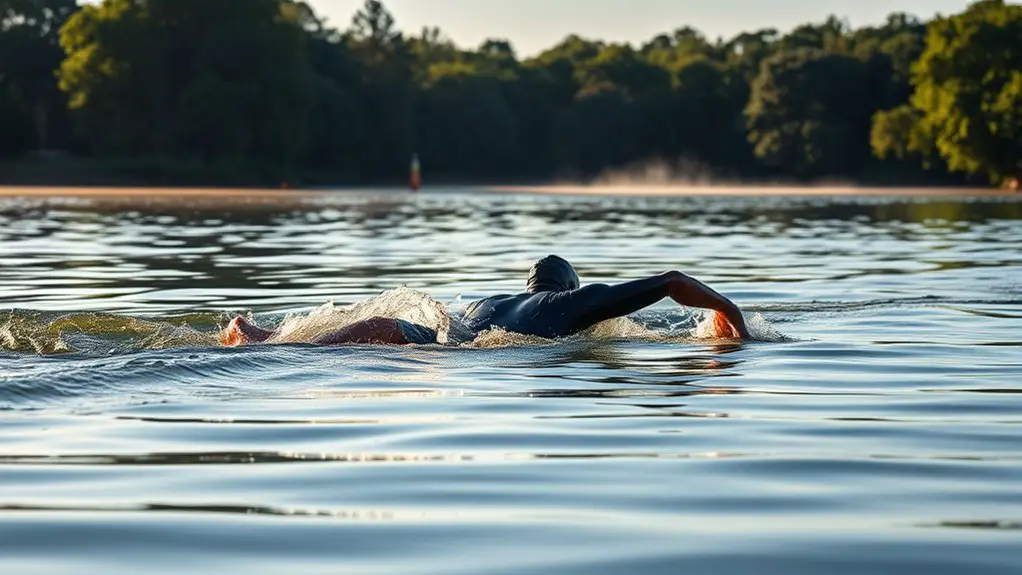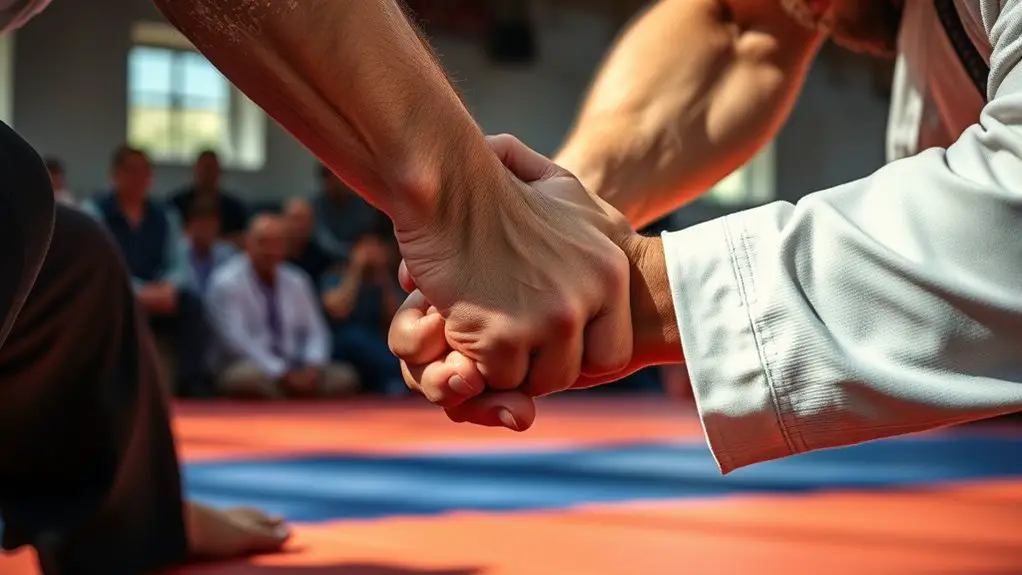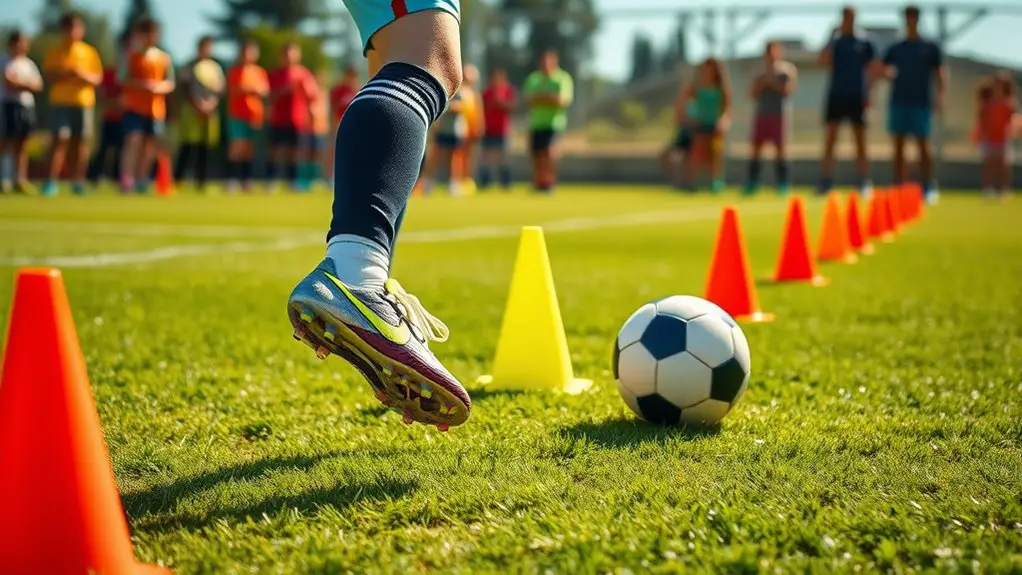To train for open water swimming endurance, focus on building your aerobic capacity through consistent long-distance workouts. Incorporate interval training to boost stamina and muscle efficiency. Pay attention to your swimming form by optimizing body position and breathing techniques. Don't forget to warm up properly with dynamic stretching and mobility drills to enhance performance. As you adjust your pacing strategies and mental preparation, you'll discover valuable insights that can elevate your open water experience.
Understanding the Unique Challenges of Open Water Swimming
When you immerse yourself in open water swimming, you'll quickly realize it presents challenges that are quite different from pool swimming. The vastness of the open water can feel liberating, but it also demands strong navigation skills. Unlike the confines of a pool, you'll need to gauge your direction based on landmarks or buoys, which can shift with the changing tides and currents.
Water conditions can vary dramatically—waves, temperature, and visibility will test your adaptability. You'll need to cultivate a keen sense of awareness, adjusting your pace and technique to match the environment. Embracing these challenges not only enhances your swimming experience but also fosters a sense of freedom as you learn to thrive in nature's unpredictable elements. By honing your navigation skills and becoming attuned to water conditions, you'll reveal the true essence of open water swimming, where each stroke brings you closer to the wild, exhilarating freedom you crave.
Building a Solid Base: The Importance of Endurance Training
Endurance is key to mastering open water swimming, as it forms the foundation for your performance and enjoyment in the water. To truly embrace the freedom of the open water, you need to build your aerobic capacity through consistent endurance workouts. These sessions should be longer and more deliberate than your typical pool training, allowing your body to adapt to sustained efforts.
Focus on gradually increasing your distance and time spent in the water, which helps improve your stamina and mental toughness. Incorporating interval training can also elevate your aerobic capacity, preparing you for the varying challenges of open water. Additionally, improving muscle efficiency can significantly reduce fatigue, enhancing your overall performance in the water.
Techniques to Improve Your Swimming Form
To swim efficiently in open water, you need to focus on optimizing your body position and mastering your breathing rhythm. A streamlined body reduces drag, while effective breathing techniques keep you calm and energized. Let's explore how these elements can elevate your swimming form.
Body Position Optimization
Optimizing your body position in the water is essential for achieving efficiency and speed in open water swimming. Focus on body alignment; keep your head in a neutral position, eyes looking forward, and your hips high. This alignment helps maintain a streamlined shape, minimizing drag. Buoyancy control is just as important; practice keeping your legs and hips afloat. You want a gentle kick that helps maintain balance without wasting energy. Try to engage your core for stability, allowing your arms to move freely. Remember, a relaxed body is a faster body. As you refine your position, you'll feel the freedom of gliding through the water effortlessly, enhancing both your endurance and enjoyment of open water swimming.
Breathing Rhythm Techniques
Mastering your breathing rhythm is essential for enhancing your swimming form and overall performance in open water. To achieve this, focus on developing effective breath control. Practice rhythmic inhalation, where you synchronize your breaths with your strokes. This not only keeps you relaxed but also helps maintain your body's alignment.
Try bilaterally breathing, alternating sides every few strokes. This technique balances your stroke and allows you to gauge conditions around you without losing rhythm. As you swim, pay attention to the timing of your breaths. Inhale quickly but deeply, and exhale steadily while your head is in the water. The more you refine your breathing rhythm, the freer and more efficient you'll feel in the open water. Enjoy the flow!
Essential Warm-Up Routines for Open Water Swimmers
Before you hit the water, it's essential to get your body ready with effective warm-up routines. Incorporating dynamic stretching techniques and pre-swim mobility drills can enhance your performance and reduce the risk of injury. Let's explore how these practices can benefit your open water swimming experience. Additionally, a proper warm-up can reduce the risk of injuries that limit swimming ability.
Dynamic Stretching Techniques
As you prepare to plunge into open water swimming, incorporating dynamic stretching techniques into your warm-up routine can greatly enhance your performance. These movements help promote dynamic flexibility, allowing your muscles and joints to move more freely. Start with leg swings to loosen your hips, followed by arm circles to warm up your shoulders. High knees and butt kicks also engage your core and legs, setting you up for a powerful swim. By focusing on these dynamic stretches, you not only improve your range of motion but also boost injury prevention. Remember, a well-prepared body is key to enjoying the freedom of open water. So take a few minutes to stretch dynamically, and feel the difference in your swim!
Pre-Swim Mobility Drills
After completing your dynamic stretching routine, it's time to focus on pre-swim mobility drills that can further prepare your body for the demands of open water swimming. These drills enhance your pre-swim mobility, ensuring your joints and muscles are primed for action. Start with arm circles and shoulder rolls to boost flexibility and loosen tight areas. Add in hip openers like leg swings to promote fluid movement in your stroke. Incorporate torso twists to engage your core and improve rotation. Finally, don't forget ankle flexibility exercises to help with kick efficiency. By integrating these mobility drills, you'll feel more liberated in the water, allowing you to embrace the freedom of open water swimming with confidence and ease.
Pacing Strategies for Long-Distance Swimming
Finding the right pacing strategy is essential for long-distance swimming, as it can make the difference between a successful race and exhaustion. On race day, you want to feel in control, not gasping for breath. Start by establishing a comfortable rhythm during your training. This helps you understand your body's limits while still allowing freedom of movement.
A common approach is the negative split, where you swim the second half faster than the first. This strategy keeps your energy intact early on and lets you surge when you've got more left in the tank.
Monitor your heart rate and perceived effort—these tools can guide your pacing strategies. Remember, it's about finding a balance. Don't be afraid to adjust your pace based on conditions like currents or temperature. Listen to your body, and embrace the experience. With the right pacing, you can glide effortlessly through the water.
Mental Preparation for Open Water Events
While the physical aspects of open water swimming are essential, mental preparation often determines your success on race day. To truly embrace the freedom of the open water, you need a strong mindset. Start by using visualization techniques to picture yourself gliding through the water, feeling the rhythm of your strokes and the buoyancy of your body. Imagine the waves, the sun, and the exhilarating sensation of conquering your fears.
Incorporate self-talk strategies to reinforce your confidence. Remind yourself that you're prepared, capable, and ready to embrace the challenge ahead. Phrases like "I am strong" or "I love this freedom" can shift your mindset and fuel your determination. Additionally, understanding the root causes of performance anxiety can help you address any lingering fears that may impact your focus.
As you prepare mentally, you'll find that your performance improves. The open water becomes not just a physical space but a playground for your spirit, where you can truly thrive. Embrace both your body and mind, and you'll soar.
Frequently Asked Questions
What Gear Do I Need for Open Water Swimming?
You'd think swimming in the open water would just require your swimsuit and a carefree attitude, right? Well, not quite! You'll need a good wetsuit—consider full suits for colder waters or shorties for warmer days. Don't forget a swim buoy; it's not just a safety measure, it's your floating freedom! With these essentials, you can glide through the waves while feeling both secure and liberated, embracing the beauty of nature around you.
How Do I Handle Water Temperature Variations?
When it comes to handling water temperature variations, start by choosing the right wetsuit thickness for your conditions. A thicker suit keeps you warmer but may feel restrictive. Use acclimatization techniques like gradually exposing yourself to colder water. Begin with short swims and slowly increase your time. This way, you can embrace the freedom of open water without the shock of temperature changes. Enjoy the adventure while staying comfortable and safe!
Can I Swim Alone in Open Water?
You can swim alone in open water, but it's important to contemplate safety precautions. The freedom of swimming solo can be exhilarating, yet the buddy system is highly recommended. Having someone with you not only enhances safety but also provides companionship. If you choose to go alone, make sure to inform someone of your plans, stay within sight of shore, and keep an eye on changing conditions to ascertain your adventure remains safe.
What Should I Eat Before an Open Water Swim?
Before your open water swim, focus on pre-swim nutrition that'll boost your energy. A light meal with carbs, like oatmeal or a banana, is perfect about 1-2 hours beforehand. Don't forget hydration strategies too—drink water or an electrolyte drink to stay refreshed. You want to feel free and light in the water, so listen to your body and adjust as needed. Enjoy the swim and let the waves carry you!
How Do I Navigate in Open Water?
Imagine you're a bird soaring above a vast ocean, free to explore. To navigate in open water, you'll want to master sighting techniques. Pick a point on land, like a buoy or a tree, and keep it in your line of sight. Use navigation strategies like breathing every few strokes to check your course. Practice this regularly, and you'll glide through the water with confidence, feeling that exhilarating sense of freedom.




